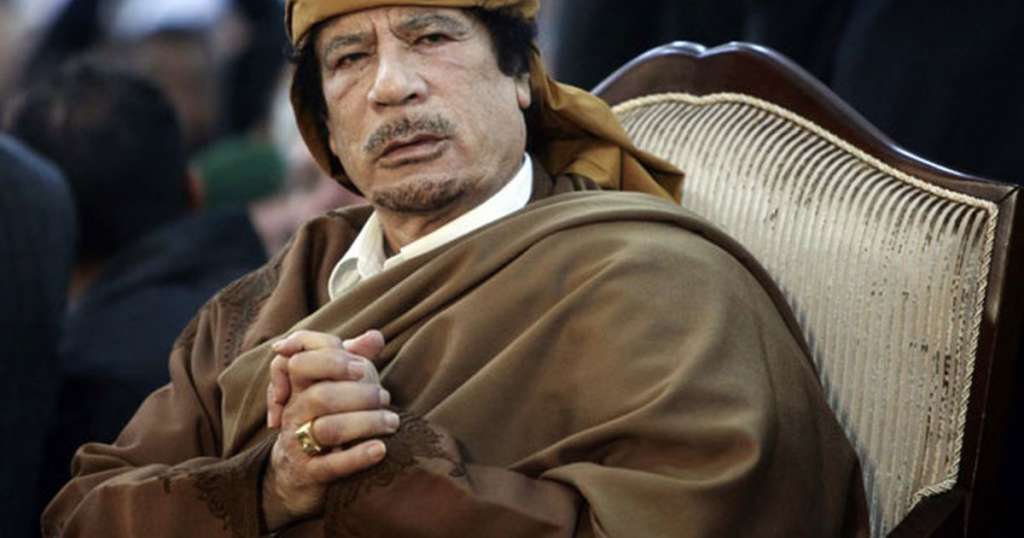Cairo- Celebrating the 47th year marking the Colonel Muammar Gaddafi-led 1969 Libyan coup d’état, two youths were caught up in an argument as to which flag stands best to commemorate the event.
The 1969 coup in Libya, also known as the al-Fateh Revolution or the September 1 Revolution, was a military-led putsch executed by the Free Officers Movement, a group of rebel military officers led by Gaddafi and that led to the overthrow of King Idris of Libya.
One of the youngsters held on to a green flag, while another argued that a white flag away from bias makes a better choice.
However, what stood out most is that the most recent star and crescent flag instated post the February 17 Libyan Revolution which toppled Gaddafi’s rule was not even an option.
Despite the Gaddafi-led revolution being called “al-Fateh Revolution”, which denotes freedom in Arabic, until this moment is seen by the colonel’s enemies as a simple realization for a lusty power grab.
Gaddafi’s movement was launched at Benghazi- which had been already ravaged by a five-year civil war.
The colonel’s rule was short to controversial, portraying a unique philosophical perspective for politics such in his published works like The Green Book. Moreover, it was the unstable and fluctuating international ties Libya failed to even out during Gaddafi’s regime that constantly left the world perplexed.
Years passed since last civil conflict before another major table-turning war awakened in Libya. This time Benghazi, set aside, with Sirte, Gaddafi’s birthplace, being in Libya’s spotlight.
Transformed into an arena for a U.S.-launched offensive against ISIS, Sirte also witnessed the death of Gaddafi in 2011.
The cousin of the slain Libyan ruler Ahmed Gaddaf Al-Dam told Asharq Al-Awsat newspaper that the fallen leader, who reigned for 42 years, knew that he had no chance in surviving or winning against NATO strikes backing the local February 17 Revolution to topple him.
Sitting with Gaddaf al-Dam, there was a white flag resting atop his office desk. A few months ago, the white flag initiative tried to launch.
The flag aims to signify the end of civil dispute and endorsing solidarity. It was to blank over Gaddafi’s green flag alongside the more recent star and crescent furnished national flag.
The white flag initiative is to whitewash the hatred and unify Libya’s politicians in hopes of salvaging the country from being lost.
Despite the white flag initiative and a newer revolution to commemorate, the 47th marking of Gaddafi’s revolution is still celebrated by the people raising the authoritarian’s green inside their homes and across public streets.
The war-torn Libyan generation showcases extreme austerity, whether loyal to Gaddafi’s former vision, or against anything relative to the eliminated ‘despot’.
Some youths supporting the recent February 17 revolution would refuse to even negotiate with former officials who had served in Gaddafi’s administration.
Despite the drawbacks and rifts downing the nation, the white flag inspiration managed to spread to the streets of Tripoli, the capital city and the largest city of Libya. Raised by protesters, the flag and the gist it signifies were confronted with militia bullets.
Seen as a peace broker and a pioneer to freedom, some of Gaddafi’s men believe that he had his image distorted by media.
Gaddaf Al-Dam, considering Gaddafi a true promoter of socialism and justice, says that ‘western liberal democracy’ is short to a charade. Referring to the public’s abstention from politics.
Gaddaf Al-Dam also mocked U.S. elections and described them as illusive ‘theatrics,’ explaining that leaders in the West are selected by company owners and capitalists and not elected.
Gaddafi’s cousin sees that the true global crisis at hand is the masonry puppeteering of international politics.
Not only former leaders in Gaddafi’s time in power believe that the authoritarian actually was a maliciously misportrayed visionary, Libyans taking refuge in Egypt are cited accepting Gaddafi’s proposed theory on an internationally woven conspiracy against Libya as a written in stone truth.
They find in an argument that during the Gaddafi-led revolution not a single Libyan was killed. Unlike the more recent revolution. Moreover, U.S. against ISIS intervention in Libya further adds to their worries.
“Gaddafi fulfilled his duty towards leading a people’s revolution in Libya. Not a single martyr had fallen… American and British military bases were removed, along with remnants of Italy’s fascism,” said Gaddaf al-Dam.
Had the leader in his cousin not gotten rid of foreign influence, the people of Libya would have never enjoyed freedom and self-determination, he added.
Defending a usually promoted a dictator, Gaddaf al-Dam explained that western media had launched a psychological war to mar the image and revolution led by Gaddafi.
Regardless, many questions arise when counting Gaddafi’s mistakes. Even more questions surface when addressing the country’s future and the difficulty of uniting against the extremists overrunning the country.
Here again, Gaddaf al-Dam addresses the West accusing it of promoting and deploying the hardline terror groups, saying that ISIS is merely a proxy doing the West’s bidding.
However, Gaddaf al-Dam, despite defending Gaddafi’s visions and philosophies, acknowledged that the late leader did commit grave mistakes.
“Gaddafi was a great leader, so were his mistakes,” he said.
What remains is that the people of Libya are still caught up amid the turmoil, left undecided. With the only certainty being that the road to reform ahead of Libya lays outstretched and long.
